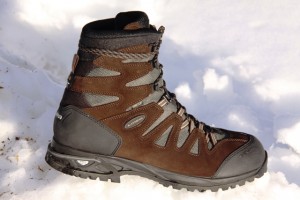
By Rick Shandley
Baikal GTX is a load bearing winter boot LOWA put some thought into. And it shows. The Baikal GTX is a stable, Partalana insulated, nine-inch-high boot you can consider for significant pack loads, warmth, comfort, and traction.
The test grounds for assessing these Baikal’s was at a mountain retreat at more than 7,000 feet elevation, and up in the trails and canyons that spider out along the Front Range of Northern Colorado. This and frequent early morning commutes to Boulder and Denver, and lots of walking in slushy winter low-traction situations outside of the work day. These boots literally saw duty from work to play on any given day for a month. And they worked great.
Uppers are an aesthetically pleasing balance of top quality suede leather and Cordura fabric mated to stiff foot lasts, stout mid-soles with rigid inserts to manage pronation and supination, and robust outsoles. Throughout the boot the stitch work is tight and flawless.
You can choose either of two color themes the Baikal GTX is available in. Color options are brown leather with medium dark gray and black Cordura fabric. A second color choice is black leather and the same shades of gray and black Cordura. Both color themes contrast nicely with the black rubber toe and heel guards. MSRP is U.S. $280.00.

This combination of boot upper construction and sole components make the Baikal GTX supportive of the foot, ankle, and lower shin to guard against twisting the foot or rolling an ankle on rocky, icy, terrain with or without a pack load.
It is also this rigid boot construction that allows you to haul winter backpack weights up around 50-plus pounds if that is one of your boot choice considerations. As you may know, you’d be less than wise to go ultra-light with your gear in snow country. You have to carry what you need, and what you might need just in case. And that makes for a hefty pack load even on an overnight trek. For me, the stiffness of the Baikal GTX is what I would want in a heavy-duty backpacking or mountaineering boot. And the Baikal GTX offers all the stability, under a load, you could ask for in a winter trail boot.
Narrow Profile
What stood out up front is a narrow overall profile in a winter boot that was worn daily in serious cold weather in snow, on ice, and in general low-temp conditions. This narrow profile, about 4.5-inches wide at the forefoot of a U.S. size 14 boot, makes a huge difference in your ability to drive a vehicle without the safety risk and awkwardness traditional (five inches or wider in a yeti-sized foot) snow boots pose.
I had taken delivery of these LOWA Baikal GTX boots and was on my way to Boulder, CO one wicked cold night in early December, when I plucked these babies out of the box. There they were in the LOWA box, when I hooked a left into a Safeway parking lot half-way to my destination, and laced them up. My single enormous reason for researching an insulated winter boot for every day cold-weather use was to find a pair that I could safely drive a vehicle in icy road conditions.
These boots are it. One cannot “safely” drive a vehicle on icy, snow covered roads, paved or dirt, with traditional, bulky snow boots on your feet. Bulky snow boots, in my size, tend to cover the accelerator and the brake pedal at once. It can be a scary deal. For driving, the rigidity of these boots took a little getting used to, but I’ll take it any time over bulky snow boots.
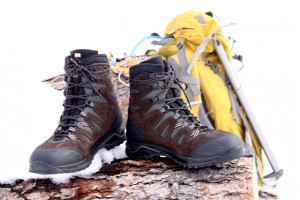
Insulation and Warmth
The thing about GOR-TEX waterproof boot lining is you have the confidence that water or moisture will not get to your feet. The GOR-TEX waterproof lining in the LOWA Baikal GTX boots. Boot interiors are lined with Partalana insulation. Partalana is a synthetic/wool blend designed for cold environments. The footbeds are also lined and insulated to keep cold from coming up through the outsoles. In any event, these relatively thin fabric liners provide insulation that keep the feet warm and dry in pretty cold weather and helped reduce the profile of the boot itself.
Warmth is a subjective, very individual, characteristic to try to quantify in broad terms. There are no comfort ranges listed for these boots. So much depends on the amount of physical activity, individual vascular circulation, and tolerance to cold weather. For the most part, my feet where warm wearing single layer, and double layer, wool-blend boot socks.
During a recent cold snap, I wore the Baikal GTX boots with early morning and night time temperatures down to less than five degrees F° with moderate physical activity. My feet where warm as long as I was active and not standing still.
Throughout the span of evaluation time I wore these Baikal GTX boots, temperatures at night and early morning where usually less than 32° and generally in the mid-to-low 20’s.
On the mild side of wearable comfort, the LOWA Baikal GTX were nice to wear in daytime temperatures up to about the mid 50’s to low 60’s. And they were never less than totally comfortable. The GORE-TEX, CORDURA, and Merino wool socks are all breathable types of fabric. Even on days when the snow is melting and the mid-day weather is mild, cold mud and melting snow can chill your feet down quick. As I experienced these boots, the wearable comfort range makes Baikal GTX a viable choice to consider for daily cold winter wear.

Comfort
Right out of the box, the LOWA Baikal GTX boots were comfortable. Sizes are US 7.5 – 12, 13, and 14. They required no break in time. My size 14 boots weigh more than the 3.5-pounds per pair of a men’s size 9 Baikal, but it’s negligible. At this relatively light weight, the Baikal GTX boots are good for wearing for hours without feeling like you’ve got a pair of honey-glazed hams strapped to your feet. They go on in the morning and come off late at night; can’t give a higher comfort rating that that.
The fabric eyelet (fore foot), composite eyelet (mid foot), and composite hook lacing system at the top of the foot allows the boot to wrap the foot, and the lace hooks, as a system, accommodate a quick lace up. This lacing system tends to work together to make the boot a unified part of the foot. Sizing is true to stated information. Never was there a hot spot, blistering, heel slipping, or overheating of the feet.
Outsole and traction
Sure there’s been the melt-offs of snowpack that panicked the ski resorts, but when the sun drops off the skyline on high country winter eves, it gets frigid quick. And the snow accumulation that doesn’t melt into the ground, well it just freezes solid every night. So, LOWA is happy with their new G3 sole technology, and can quantify good traction on slippery surfaces. The G3 sole unit offers supination and pronation support, a heavy-duty polyurethane (PU) midsole, and an outsole that improves traction on snow and ice by as much as 32-percent.
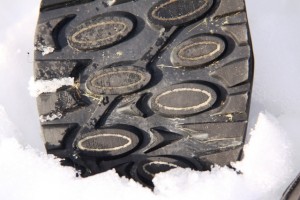
Regardless, the outsoles worked well in the myriad of ground and weather conditions this pair of Baikal GTX boots have been exposed to. That includes light snow over ice, heavy wind, deep snow, drift snow (with snow pants and gaiters on), mud, slush, and freezing rain.
That said, ice is ice, and you will never have the upper hand. You can only manage the downside. Yes, I slipped on ice wearing these boots. But my general confidence in the traction is high. And the frequency of a chance to slip on ice is every single day for a good part of the day when outdoors. Walking on icy roads, ranch land and terrain, it is inevitable. But I did experience solid traction in most icy conditions where there could be an inch of fresh snow on top of hard-glazed ice from previous snowfalls and the cycle of melt-freeze-melt-freeze that occurs frequently. This in no way takes away from the improved traction the G3 sole unit offers. You have to be hyper-aware of foot placement, weight transfer, and balance on icy terrain…even with crampons on your boots.
LOWA used European Norms (EN) valuations to measure traction on ice, ceramic, and steel; all slippery surfaces. LOWA engineers focused on various low-temperature soft rubber compounds that offered stickiness and designed traction lugs, and sole pattern, that put at least one traction lug in contact with the ground surface at all times. Within these strategically placed traction lugs, LOWA built loops of fabric with enough texture to potentially enhance traction. One primary lug is a contact patch at all times during the foot stride, and each lug has a fabric loop that adds a non-rubber traction aid. It makes sense, and traction on ice is commendable. There are plenty of voids between sole lugs and traction features to allow water, mud, or slush to self-clean in the process of walking.
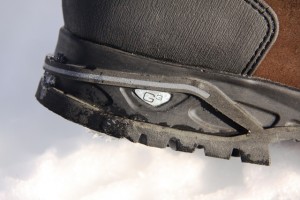
To take it a step further, and to get a little closer to what real snow tires do to make the claim “Snow tires for your feet,” LOWA can use tread micro-sipes on all the featureless surface area that remains across the outsoles. Siping is a practice of molding or cutting fine lateral grooves or slits on the tread of a true snow tire, like the Pirreli Scorpion Snow and Ice tire for instance. Look at any high-end winter tire and you’ll find tread siping for additional ice-biting capability. Siping is standard on a modern snow and ice tire, so why not have them on a boot outsole? The advantage is the same.
By way of experience with snow tires, much of my earlier media career was based in the automotive performance aftermarket. After many new tire product launches, winter driving schools, tire reviews and the subject of rubber compounds, tire savvy and traction are serious topics. Siping adds another dimension to traction on ice that LOWA can incorporate into their outsole design. A 32-percent increase in traction is a measureable improvement, but there is still 68-percent traction left on the table.
Overall, LOWA Baikal GTX boots are awesome winter boots that have performed in a stellar manner day in and day out so far during the winter of 2011/12. It’s easy to recommend these winter boots for a myriad of reasons, not the least of which are comfort and warmth. It would be nice to see a boot like this have available information as to the general comfort range its insulation is designed for.
Here’s something you don’t expect in a winter boot: When the weather is frigid, schools are closed, and the roads may or may not be free of snow, these LOWA Baikal GTX boots look perfectly fine poking out of the pant cuffs in professional business casual dress attire. When they get muddy from a couple days of melt-off, I just turn on the hot water hydrant in the barn and rinse them off while they are still on my feet. They clean up nice.

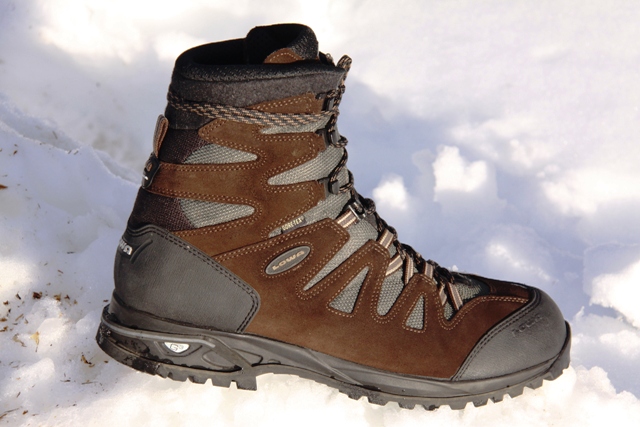



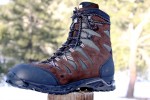






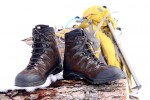
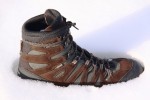
Love reviews like these that give the full picture of how a boot can serve in multiple scenarios—on the trail, in snow or in a vehicle. Thanks so much, Rick!
CORDURA(R) Brand
Account Manager